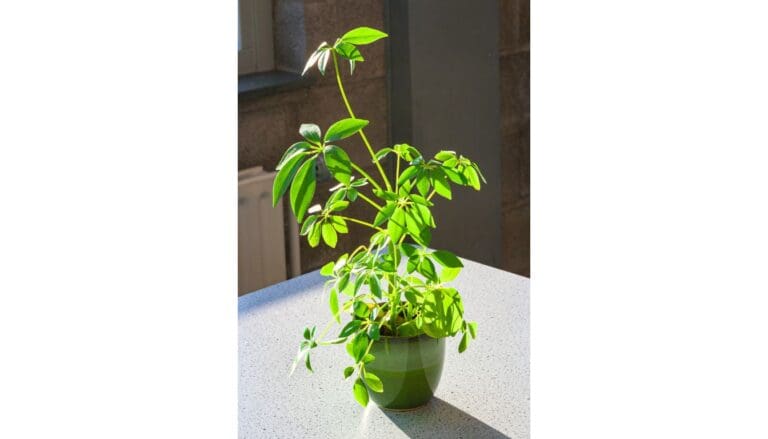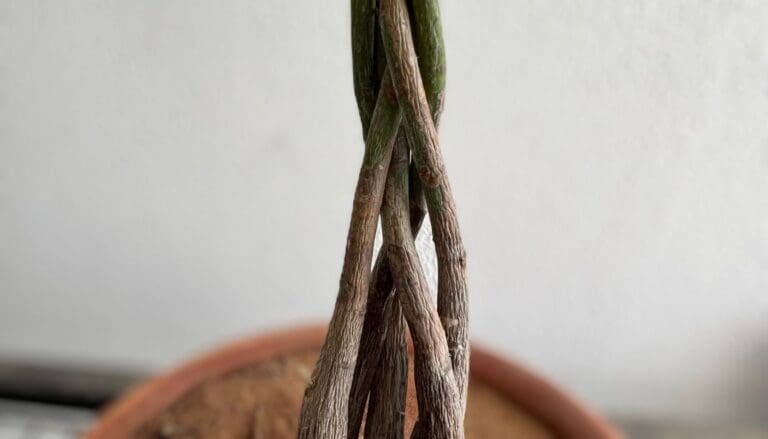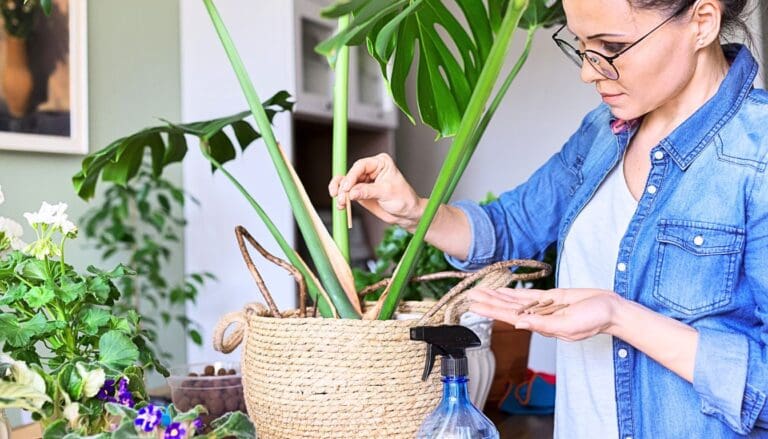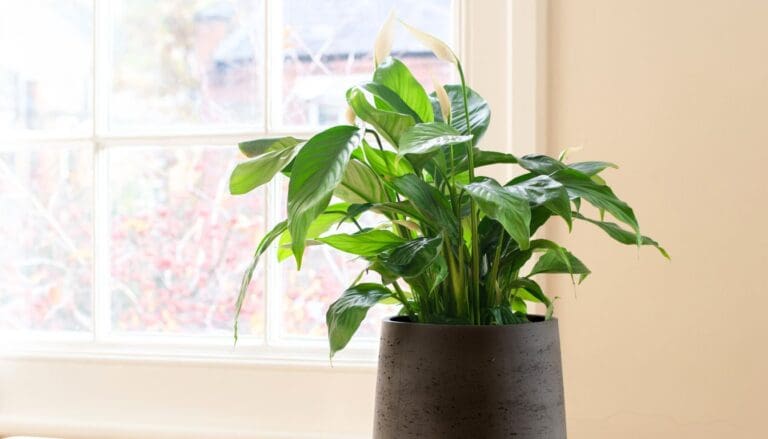Is English Ivy Poisonous To Pets? (Signs, What To Do)
English Ivy (Hedera Helix) is a climbing vine popular due to its low maintenance and attractive appeal. If you have pets in the house but plan to get an English ivy, you might wonder if this plant is toxic for pets. Let’s find out.
As per guidelines issued by ASPCA, English Ivy is toxic for most pets like dogs and cats. Munching the leaves of this plant will cause health issues like gastrointestinal distress, vomiting, diarrhea, etc. It can cause breathing problems, liver failure, and even death if consumed in large amounts.
English ivy contains triterpenoid saponin, a steroid responsible for plant toxicity. This sap is toxic to small and large pets and humans. Today, I will explain why English ivy is not safe for pets.

Please note: Simplify Plants is reader-supported. Some links in the post are affiliate links and I get a commission from purchases made through links in the post.
Is English Ivy safe for pets?
English Ivy is not safe for pets.
If your dogs and cats touch this plant, they might experience skin rashes and infections.
Consuming any part can cause various health problems like swelling, diarrhea, gastrointestinal distress, vomiting, nausea, and abdominal pain.
If the pet consumes this plant for a prolonged period, it can sometimes face difficulty breathing and even organ failure.
How toxic is English Ivy?
English ivy contains naturally occurring steroids known as sapogenin and polyacetylene compounds.
These chemicals are highly toxic and irritate skin and mucus membranes if chewed or swallowed.
All the parts of the English Ivy plant have toxins, especially concentrated in the leaves.
The toxicity of the English ivy is severely dangerous, and you should contact a vet as soon as possible if your pet ingests it.
The consumption of the leaves causes vomiting, diarrhea, excessive salivation, or gastrointestinal distress, and the sap can cause rashes to the skin.
The leaves taste slightly bitter and have an unpleasant smell, so your pet shouldn’t consume much.
But if it consumes the plant in large amounts, it will face issues like allergic dermatitis, blistering, cardiac abnormalities, etc.
Signs of English ivy toxicity
English Ivy can cause various problems to both humans and pets.
The toxicity of this plant will depend on the amount of consumption.
Let us look at the signs to understand them better.
- Munching the leaves of English Ivy can cause a burning sensation in and around the mouth.
- There can be excessive salivation, swelling, choking, and pain.
- Ingestion of smaller quantities can lead to diarrhea, loss of appetite, abdominal pain, nausea, and vomiting.
- Ingestion of large amounts can cause serious issues like breathing difficulty, redness in the skin, blistering, dermatitis, kidney failure, and paralysis.
- You can save your pet from sapogenin toxicity, but in many cases, liver and kidney damage occurs that is difficult to cure.
What to do if my dog eats English Ivy?

English Ivy can be dangerous to your dog.
The consumption of any part can cause serious effects.
Some signs you might notice are:
- Vomiting
- Drooling
- Diarrhea
- Redness in skin
- Burning sensation in mouth, lips, and throat
- Itchiness and irritation
- Abdominal pain
- Nausea
- Loss of appetite
- Swelling
- Liver failure
If you think your dog has munched any part of the Ivy, take it to a vet without delay.
Do not risk your dog’s life by giving him any medicines or treatment without a doctor’s consult.
This includes trying to make your dog vomit which will make the condition worse.
Trying home remedies can delay professional help.
The sooner you take your dog to the vet, the better the chances for its health improvement.
The treatment will depend on the amount of consumption and your dog’s overall size and health.
For example, a puppy that eats some leaves will face a worse case of diarrhea and vomiting than an adult dog who has eaten the same quantity.
If your dog has eaten a very small quantity of the plant and you caught it eating, the treatment will be different.
Whether your houseplants are toxic or not, keeping them away from your pets is always better to prevent any mishap.
Is English Ivy poisonous to cats?

The toxicity effect on your cat will depend on the amount of consumption.
Cats are curious about any new thing around them, including houseplants.
The leaves and berries of English ivy contain steroids called terpenoid saponin that can irritate and harm your cats.
The steroids are insoluble toxins, and repeated consumption will cause your cat to end up in a coma or have paralysis.
Here are the signs of English Ivy poisoning in your cat:
- Severe skin allergies and irritation
- Vomiting
- Upset stomach
- Intense inflammation in the mouth, lips, and throat
- Decreased appetite
- Swelling and blistering in the mouth
- Pawing at mouth
- Itchiness in skin
- Breathing problems
- Depression
- Live failure
- Coma or paralysis
English Ivy produces an unpleasant smell, so it’s rare for your cat to consume massive amounts.
However, you should contact your local vet if your cat has touched, eaten, or inhaled the plant.
The treatment will depend on the level of ingestion and the cat’s symptoms.
If the ingestion is minor, remove the plant parts from the cat’s mouth and offer tuna juice or cold milk.
But If you notice that your cat is behaving abnormally and showing symptoms of discomfort or illness, rush to a vet immediately to seek advice.
After looking at your cat’s condition, the vet can remove the plant’s tissues from the pet’s mouth and give her medication or fluid therapy to reduce vomiting.
Kittens are at more risk than cats.
Therefore, keeping plants away from your cat’s reach is important.
Is English Ivy toxic to rabbits and other small pets?
English ivies are highly poisonous to rabbits.
The leaves and berries of Ivy have high toxic content, and your bunnies will rarely be able to survive after ingesting it.
Rabbits can suffer from various health problems such as:
- Insomnia
- Lethargy
- Decreased appetite
- Intestinal congestion
- Diarrhea
- External and internal bleeding
- Abdominal tenderness
- Difficulty in breathing and collapsed paralysis
However, they will not get skin rashes as the oil in their fur protects the skin from the plant.
Rabbits are less familiar with vines, so they usually avoid them due to snacking on sweet vegetables.
English ivies are also poisonous to other small pets like guinea pigs and squirrels.
If your small pets have eaten any part of this plant, it is worth seeking a veterinarian’s advice.
If you are growing your Ivy plant close to where your small pets are, remove it to a place where they cannot go.
Is English Ivy poisonous to birds?
It is natural for birds to eat plants.
They can even get curious and consume different parts of your English Ivy.
Hence, knowing which plants are harmful to your feather friends is essential.
High ingestion of English Ivy can even kill the birds.
The good thing is that the birds can’t consume in high quantities since they like to play and shred with the plant more.
Therefore, the poisoning can’t be severe.
However, mild consumption will cause skin irritation and mouth infections.
If the bird comes in contact with the English ivy, it will show the following symptoms of poor health:
- Gastrointestinal issues
- Skin irritation
- Mouth infections
- Convulsions
- Vomiting
- Depression
Keep your English ivy where the birds can’t reach it.
What should I do if my pet eats English Ivy?

Always try to keep your pets and children away from the English Ivy.
Pets like cats and dogs are very playful and get excited whenever they see anything new around them.
They try to inspect the new things by licking and smelling them.
So, maintain boundaries between your pets and plants.
If your pets have touched, smelled, or consumed the English Ivy, consider the following:
- First, look carefully at your pet and observe signs or symptoms of poisoning.
- Open your pet’s mouth, and check if you can spot any plant part. If you can, remove it.
- Feed your pet with cold milk to soothe the irritation.
- If you notice serious symptoms like a breathing disorder, swollen mouth, repeated vomiting, or abnormal behavior, consult a vet to give your pet the necessary treatments. You can bring a plant sample.
After looking at your pet’s condition, the vet will ask you questions about your pet’s behavior or questions related to any medicines or supplements you are providing your pet.
Explain everything in detail to the vet without hiding any facts.
He will then perform various tests on your pet to determine to what extent your pet has been affected.
He may do a blood test or urinalysis to reveal the level of toxicity, imbalances, or any underlying disease.
Also, the blemishes on the skin from the contact of sap will be studied.
The vet will start the treatment by removing the leftover from its mouth and washing the mouth with clean water.
The vet may offer ice cubes to your cat and dog to reduce the swelling and pain in the mouth.
If the consumption is not high and the symptoms are minor, your pets will recover in a few days with the right medication.
But if the toxic reaction is very severe, the vet will continue the treatment for an extended period.
When there is excessive vomiting or diarrhea, the vet may bring your pet to their office for supportive treatment.
How do I keep my pet away from English Ivy?
Do not keep the English Ivy near your pet, as a minor casualty can cause a lot of harassment.
You must watch your pet every time if you still keep the English Ivy in a spot where your pets can reach.
Pets are always excited to touch and play with new things, including plants, so the owner must maintain boundaries.
Place your English Ivy anywhere the pets can’t reach it.
For example, move your Ivy plant to a window or a high spot so the pets can’t go there.

How do I keep my dog away from English Ivy?
Dogs are the most obedient pets, and you can easily train them to follow your instructions.
But they can get naughty at times and disobey you.
A few things you should remember:
- If you place your English Ivy on the floor and notice leaves falling from it, remove them immediately before your dogs smell them.
- Do not keep your Ivy on a stand, be careful as your dog can push it.
- Keep your English Ivy on the balcony or a high shelf so your dog can’t reach it.
- Restrict your dog to an area away from the Ivy if you plan to go out.
- You can keep your plant on higher self to keep it away from your dog’s reach.
How can I keep my cat away from English Ivy?
Cats are moody pets that might not get trained easily.
They can be very naughty sometimes.
Hence, keeping cats and plants together is not safe.
A few tips to keep your cats away from your English Ivy:
- Spread some orange peels around the plant. Cats dislike citrus, and this trick will keep them away from your plant.
- Fill a spray bottle with water. Use it on your cat whenever you notice her visiting your plant.
- Give your cats toys to play with. The toys will keep them busy, and they will go near the plant.
- Keep your plant in a place such as higher shelves or windows your cats can’t reach.
How do I keep my birds away from English Ivy?
Use the following tips to keep them away from your Ivy.
- Birds are scared of snakes, so hang a few rubber snakes around your English Ivy.
- Buy scarecrows from the market and put one near the plant to keep the birds away.
- Put ultrasonic trainers that emit sounds that birds do not like.
- Put an aluminum screening to keep your birds away from your Ivy.
Final words
English Ivy is a poisonous plant for pets. So, you should not let your pets go near it. If you think your pet has touched or consumed any part of the Ivy, consider consulting and visiting the vet.
Keep your English Ivy at a spot that is not accessible for your pets. You can also try the methods I mentioned in this article.
Reference: Researchgate, University of Tennessee, Mississippi State University, Central Florida Research and Education Center, U.S. DEPARTMENT OF AGRICULTURE, Plants harmful for small pets.
Recommended Garden Supplies
| Product Image | Our Recommended Gardening Supplies | Check Offers! |
|---|---|---|
Top Top
Top
Top
Top
Top
Top
Top
Top | rePotme Houseplant and Tropical Classic Potting Soil Mix | Check Offer On Amazon |
 Top
Top
Top
Top
Top
Top
Top
Top | Espoma Organic Indoor Plant Food | Check Offer On Amazon |
 Top
Top
Top
Top
Top
Top
Top
Top | GooingTop LED Grow Light 6000K Full Spectrum Clip Plant Growing Lamp | Check Offer On Amazon |
 Top
Top
Top
Top
Top
Top
Top
Top | Soil Moisture Meter | Check Offer On Amazon |
 Top
Top
Top
Top
Top
Top
Top
Top | Govee Hygrometer Thermometer, Bluetooth Enabled! | Check Offer On Amazon |
 Top
Top | LEVOIT Humidifiers for Large Room(Best For Plants) | Check Offer On Amazon |
 Top
Top
Top
Top
Top
Top
Top
Top | Upgraded DIY Automatic Drip Irrigation Kit, 15 Potted Houseplants Support | Check Offer On Amazon |
 Top
Top
Top
Top
Top
Top
Top
Top | Stainless Steel Heavy Duty Gardening Tool Set | Check Offer On Amazon |
 Top
Top
Top
Top
Top
Top
Top
Top | Bonide Insecticidal Soap | Check Offer On Amazon |
 Top
Top
Top
Top
Top
Top
Top
Top | Bonide 32 oz Spray Neem Oil for Organic Gardening | Check Offer On Amazon |
 Top
Top
Top
Top
Top
Top
Top
Top | Garden Safe Fungicide | Check Offer On Amazon |






